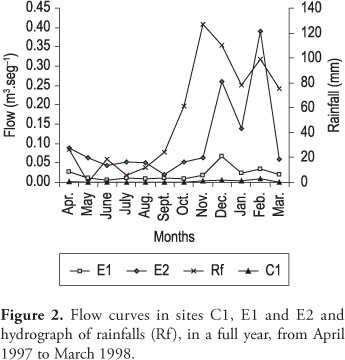AIM: The purpose of this work was to determine genera diversity, structural attributes and distribution of the Hydrachnidia assemblages and their possible influences with certain abiotic parameters along the sub-basin of the Grande River, a 6th order stream in the province of San Luis; METHODS: four sampling sites (C1, E1, E2 and E3) were established in two different hydrological periods: high waters (HW) and low waters (LW). Twenty-four samples were obtained using Surber sampler, and the hydraulic, physical and chemical characterization of the sampling sites was carried out. Density (ind.m-2), genus richness, Shannon-Wiener diversity index and Kownacki's dominance index were calculated; RESULTS: sixteen Hydrachnidia genera were observed. No significant differences were found between the abiotic parameters of each site. A positive correlation of Sperchon, Torrentícola and Neoatractides was observed in relation to flow and current velocity whereas Hygrobates showed a negative correlation. No significant differences were observed in Hydrachnidia abundances among the sites in HW and LW and between the pairs of each site in HW and LW. The genera with the highest densities were Hygrobates, Limnesia and Atractides, of which the first two were widely distributed. The rest only appeared sporadically. According to Kownacki's index Hygrobates and Limnesia were "dominant", Atractides were "subdominant" and the rest were "non dominant"; CONCLUSIONS: The found genera were distanced systematically and philogenetically. However, the specimens belonging to these genera exhibited very similar morphological characteristics, which were adaptations to rheophilous habitats. The representativity of Hygrobates and Limnesia might be due to the great abundance of their hosts and preys in the sub-basin. The decrease in the densities and the changes in the Hydrachnidia composition in E3 (post-dam site) might be explained by the biotic interactions previously mentioned.
rheophilous Hydrachnidia; generic richness; spatio-temporal distribution; hydraulic parameters










